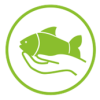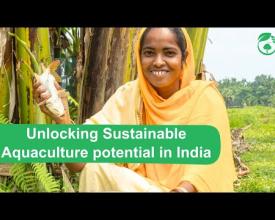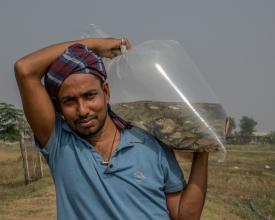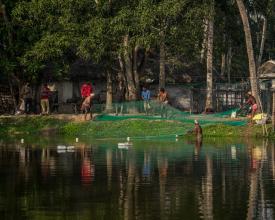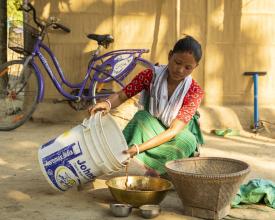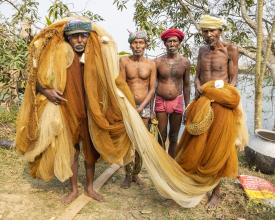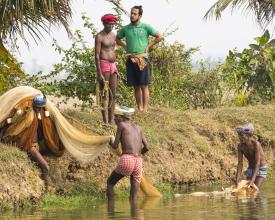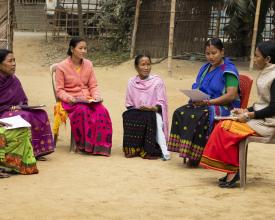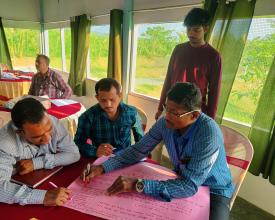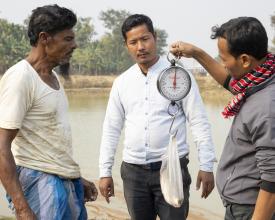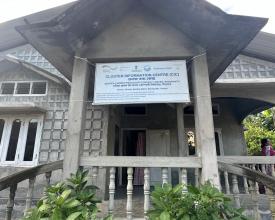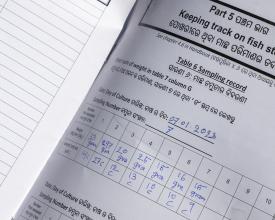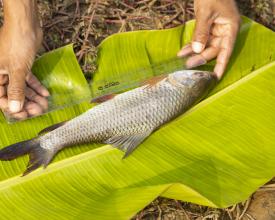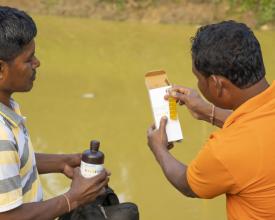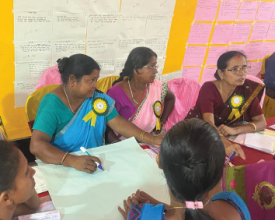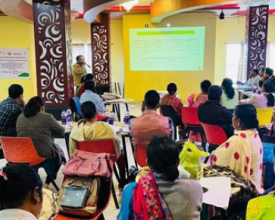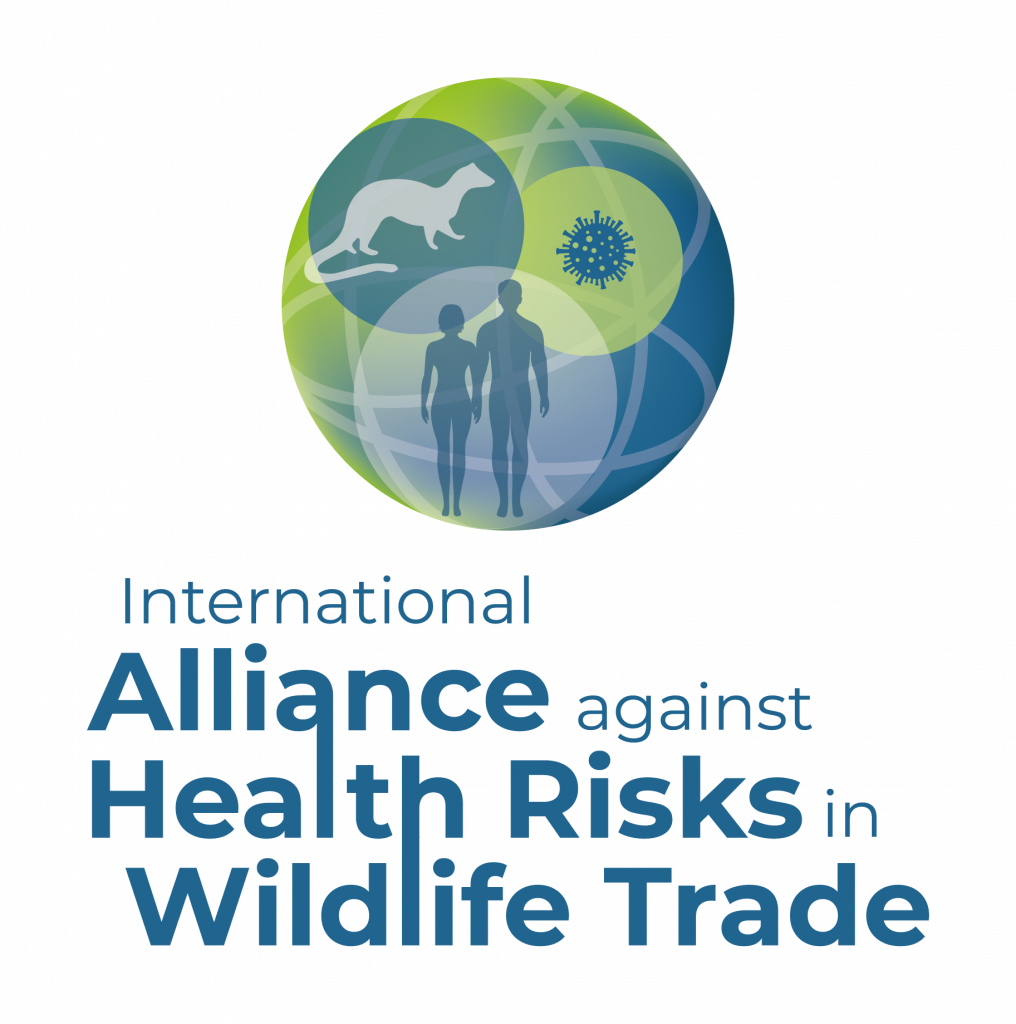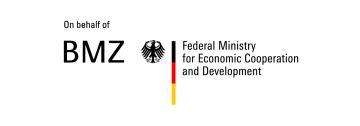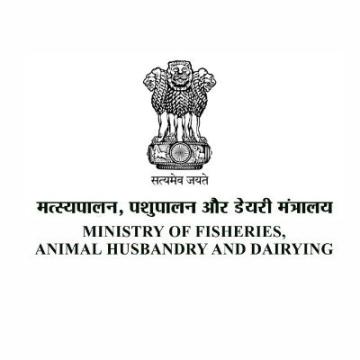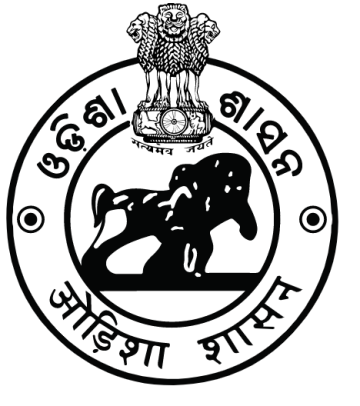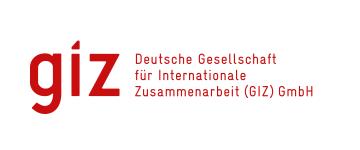
Sustainable Aquaculture for Food and Livelihood
India’s states of Assam in the north-east and Odisha on the east coast, have long standing traditions of aquaculture cultivation, which play an important role in sustaining food and nutrition security and strengthening livelihoods. Both states hold large areas suitable for sustainable aquaculture of often yet unexplored potential.
The Indo-German Development Cooperation Project “Food Security through Integrated Aquaculture” (EIAA) is part of the GIZ Global Programme on Sustainable Fisheries and Aquaculture (GP Fish). The project, locally known as Sustainable Aquaculture for Food and Livelihood (SAFAL), aspires to provide more fish products for the food-insecure population and higher income from sustainable and resource-efficient pond-based aquaculture in Assam and Odisha. The project is funded by the German Federal Ministry for Economic Cooperation and Development (BMZ) and implemented by GIZ in partnership with the Ministry of Fisheries, Animal Husbandry and Dairying (MoFAHD), Government of India between 2021-2025.
Context
Challenges addressed
Major challenges for low productivity of sustainable aquaculture (SA) are a lack of access to high-quality fingerlings and feed, limited knowledge of operators and poor access to national funding programmes. Small producers require advisory services on technical innovations, profitability, financial services, and organisational development. Supplying these services promotes the transformation of subsistence farmers into small business owners to ensure the availability of fish products for better nutrition for the local population. An increase in production is aimed to be achieved by training farmers, extension service producer known as Community Resource Person (CRPs), Farmer Producer Organisations and Companies (FPO, FPC), and women Self-Help Groups (SHGs) in resource-conserving and efficient pond management in combination with improved access to high-quality fingerlings and feed. Experiences from the project are additionally supporting the institutionalisation of SA practices in the state government frameworks.
Location
Process
Summary of the process
The building blocks of the GIZ SAFAL project interact cohesively to create a sustainable aquaculture ecosystem. Capacity Development & Extension Services, using the Community Resource Person (CRP) model, empower local farmers through peer-led training. The Aquaculture Business School equips farmers with business skills, while Knowledge Products and IEC materials ensure the dissemination of practical, culturally relevant information. The Farmer Institution Real Time Monitoring System (FIRMS) tracks progress and supports decision-making. The Aqua Entrepreneurship Initiative fosters innovation and financial independence, while the Participatory Guarantee System ensures sustainable practices. Agroecological Kiosks and Community Information Centres provide vital access to resources and information, enabling farmers to thrive. Together, these building blocks create a self-reinforcing system for sustainable aquaculture growth.
Building Blocks
Capacity Development & Extension Service: Community Resource Person Model
The Community Resource Person (CRP) model in India is a community-driven approach to development and empowerment, particularly in rural areas. It involves identifying and training individuals from local communities to act as extension service providers, advisers, and mobilizers to address various socio-economic challenges and promote sustainable development.
Under the SAFAL project more than 140+ CRP trainers (Train the Trainer, ToT) and 500+ CRPs and have been trained between 2021 and 2023 in Assam and Odisha. CRPs themselves are aquaculture farmer belonging to the local farmer institutions who are supporting up to 25 farmers. Up to now, CRPs are providing trainings and extension and advisory services to more than 7.000 farmers in rural areas on sustainable aquaculture practices to their communities.
The selection process of CRPs involves several step starting from registration, selection among co-created criteria as well as following recommendations from farmer institutions such as Farmer Producer Organisations (FPOs) and Self-Help-Groups (SHGs) followed by an intensive capacity building course.
The training, likewise, for CRPs and CRP-to-farmers, are conducted in tailored sessions conducted with the help of Knowledge Products (KPs) and Information, Education & Communication (IEC) material, such as the Farmer’s Handbook, a Training Manual for Trainers, the Farm Record Book and various training material. Those were co-created among scientists, government officials, experts in sustainable aquaculture practices, aquaculture operators and SAFAL technical to fit the exact needs of the local farmers.
The training cascade contains basic and advanced modules using the didactic methodology for easy adoption of adult learning. The program consists of 30 per cent classroom and 70 per cent hands-on training as well as exposure visits to state-of-the arts hatcheries and research and educational institutions within different states. Making it accessible and inclusive to farmers all over, it is translated into local languages and designed in a way that it can be held in remote and rural areas using flipbooks, posters, and pamphlets to teach without access to electronics.
CRPs are based within their farmer institutions (FPOs, FPCs, SHGs) and are motivated by social, environmental, and financial incentives, including selling goods and services, and facilitating access to finance.
Through this self-financed CRP model, thousands of small-scale farmers are empowered with knowledge and resources. This ground-level approach boosts yields within planetary boundaries while ensuring nutrition and food security.
You can find more information about the training materials (knowledge products and Information, Education & Communication material) and download them in the building block: Knowledge Products and Information, Education & Communication Material.
Enabling factors
- Tailored Training: Offering training sessions tailored to the needs and capacities of small-scale farmers, with a focus on practical knowledge and skills relevant to their specific contexts.
- Multiplier Effect: Employing a Training of Trainers (ToT) approach to multiply the impact of training efforts, enabling CRPs to train and support a larger number of farmers.
- Effective Extension Services: Utilizing a network of Community Resource Persons (CRPs) who act as extension workers, delivering training, knowledge, and support directly to farmers in their local areas.
- Participatory Approach: Involving farmers directly in the learning process, allowing for a bottom-up approach that considers their perspectives, challenges, and needs.
- Financial Incentives: Motivating CRPs through a combination of financial incentives, such as selling fingerlings, retail opportunities of farming equipment, as well as non-financial incentives like recognition and social impact.
- Access to Finance: Supporting farmers in accessing finance through guidance and facilitation e.g., through record keeping, to relevant financial institutions and government schemes.
- Government Support and Alignment: Aligning with government priorities and policies, and demonstrating the effectiveness of these models to policymakers, which can lead to increased support, funding, and scalability.
Additionally:
- Quality Course Materials: Providing high-quality course materials co-created among local stakeholder and experts, ensuring the content is accurate, relevant, and accessible to farmers.
- Local Context Sensitivity: Designing training models and materials that are sensitive to the local context, including cultural, social, economic, and environmental factors.
Lesson learned
- Customization is Key: Tailoring training sessions and materials to the specific needs, challenges, and contexts of small-scale farmers enhances relevance and effectiveness.
- Empowerment through Education: Providing farmers with training material to gain practical knowledge and skills empowers them to make informed decisions, improve their practices, and enhance their livelihoods.
- Local Ownership and Engagement: Involving farmers directly in the learning process fosters ownership, buy-in, and sustainability of interventions.
- Importance of Extension Services: Utilizing a network of Community Resource Persons (CRPs) as extension workers effectively delivers training and support at the grassroots level.
- Selection of Multipliers: Optimizing capacity-building efforts to maximize knowledge retention requires a strategic approach in the selection of promising CRPs among the community.
- Financial Incentives Drive Engagement: Offering financial incentives, such as income opportunities, motivates CRPs and encourages their active participation and commitment.
- Collaboration Amplifies Impact: Collaborating with Farmer Institutions, SHGs, and other stakeholders enables aggregation of resources, knowledge-sharing, and amplification of impact.
- Access to Finance is Critical: Facilitating access to finance empowers farmers to invest in their businesses, adopt new practices, and improve productivity and profitability.
- Local Context Matters: Sensitivity to the local context, including cultural, social, economic, and environmental factors, is essential for the relevance and success of interventions.
- Training of Trainers Multiplies Impact: Leveraging a Training of Trainers (ToT) approach enables the multiplication of training efforts, reaching a larger number of farmers and communities.
- Alignment with Government Priorities: Aligning with government priorities and policies can facilitate support, funding, and scalability of interventions, making them more sustainable and impactful in the long run.
Resources
Aquaculture Business School: Empowering Farmers through Sustainable Growth
The concept of Aquaculture Business School (ABS) revolved around providing education and training focused on Fish as Farming a Business. The concept of ABS assumes that one of the farmer’s sources of income is generated from fish cultivation, complemented by two other agricultural activities e.g., duck farming and rice cultivation. It has been designed as replication of the Farmer Business School, successfully established by the GIZ Agri Business Facility in African countries. Under SAFAL, together with the Ministry of Rural Development, Government of India and the Assam Rural Livelihood Mission the model has been tailored towards the aquaculture sector in India and for the first time implemented in India’s state of Assam.
The training of ABS-Trainer (Training of Trainer, ToT) aims at enhancing the skills of teaching adult learning and knowledge of trainers in making business decisions and forecasting business risks.
During the five-day ABS-Trainer-to-farmer training the participants covers the topics of assessment of profitability and investment needs, risk analysis, creation of a diversifying income strategies, annual business planning and entrepreneurial management.
Aquaculture Business School is about professionalizing producer initiatives, management, and demand for services and inputs.
- Assessing profitability, and investment needs.
- Risk analysis and mitigation plan over five years.
- Income increases and income diversification.
- Higher efficiency and better quality of production.
- Personal freedom, informed decision-making, and investment.
- Professional ethics and behaviour as entrepreneurs.
The ABS model aims to empower farmers economically while adapting to local conditions and promoting sustainability.
During the first half of 2024 a master trainer was hired to train 20 ABS-trainers (ToT) in Assam. The training included equipping the participants with theoretical knowledge and allowed them to improve their training delivery through pair-learning and feedback sessions. The trained ABS-Trainer have reached out to 2000+ farmers by March 2025. Another 2000+ farmers are planned to be reached out to throughout 2025/2026.
Enabling factors
- Curriculum: ABSs offer a curriculum that integrates aquaculture with agricultural practices with business principles. Courses cover a wide range of topics, including agricultural economics, agribusiness management, marketing, finance, supply chain management, risk management, entrepreneurship, and sustainable agriculture practices.
- Practical Learning: ABSs emphasize practical, hands-on learning experiences to complement theoretical knowledge. Students engage in and learn to apply their knowledge in case studies, simulations exposing them to real-world agricultural business scenarios and challenges.
- Entrepreneurship Development: ABSs cultivate an entrepreneurial mindset among farmers in rural communities and aspiring aquaculture entrepreneurs.
Lesson learned
- Increased Profitability: Farmers learn business skills that help them manage their operations more effectively, leading to higher profits.
- Income Diversification: Farmers learned to diversify income streams, which has been effectively linked to ongoing government schemes like Lakhpati Didi, helping farmers improve financial resilience and stability.
- Improved Market Access: Training on market-oriented production enables farmers to better understand market demands and access higher-value markets.
- Enhanced Technical Skills: Farmers gain practical knowledge and techniques that improve their productivity and sustainability.
- Stronger Networks: Participation fosters connections with other farmers, service providers, and institutions, which can lead to new opportunities and support.
- Greater Self-Reliance: The training empowers farmers with the confidence and skills to independently manage and grow their businesses.
- Sustainable Practices: Farmers learn sustainable farming and aquaculture practices, which can lead to long-term benefits for their livelihoods and the environment.
- Adaptability to Change: The program helps farmers become more adaptable and resilient to market and environmental changes.
Capacity Development: Knowledge Products and Information, Education & Communication material
When SAFAL started reaching out to aquaculture farmers in 2021, two of the key aspects to enhancing the availability of fish and income through sustainable aquaculture became apparent: the gap on technical knowledge and financial literacy on aquaculture operations and the difficulty of accessing financial support through existing schemes.
For farmers, harnessing the potential for expansion of their practises required acquiring new technical skills, proper planning as well as investments into their operations. SAFAL set up an inclusive community-based training cascade (see building block: CRP model) which required the development of quality course materials, tailored to the local requirements. Under consideration of reviewing and harmonizing existing material, new state of the art training materials and best practices for sustainable aquaculture were co-created in a participatory manner among scientists, government officials, experts in sustainable aquaculture practices, aquaculture operators and SAFAL technical staff.
The knowledge products and IEC material created under SAFAL are integrated with each other and can be used individually or collectively. While they follow a session schedule covering the whole training cascade and cultivation sesason, learners can also utilize them individually by choosing seasonally applicably chapters or topics of their interest.
The KPs and IEC material are distributed through the CRP-to-Farmer training (see building block: CRP model) they are also placed in CICs and SCs (see building block: Agroecological Kiosks).
Enabling factors
- Holistic Skill Development: Comprehensive, practical guides cover all aspects of sustainable aquaculture, equipping farmers with the necessary knowledge for the entire season.
- Integrated Learning: Training materials combine technical, economic, social, and environmental aspects, promoting a balanced and sustainable approach to aquaculture.
- Seasonal Flexibility: Modular and adaptable materials allow farmers to learn and apply relevant lessons at any stage, supporting continuous improvement.
- Local Adaptation: Culturally relevant content and local examples ensure greater acceptance and practical application of sustainable practices.
- Gender Sensitivity: Gender-inclusive materials and role models encourage broader participation and empower women in aquaculture.
Lesson learned
- Enhanced Technical Skills: Farmers gained essential technical knowledge and financial literacy, improving their aquaculture practices and profitability.
- Practical Implementation: Real-time, step-by-step guidance helped farmers apply sustainable practices effectively, boosting confidence and problem-solving abilities.
- Cultural Relevance: Customized, locally adapted training materials made it easier for farmers to adopt new practices.
- Gender Inclusivity: The gender-sensitive approach promoted equal opportunities, empowering more women to participate in aquaculture
Resources
Agroecological Kiosks: Community Information Centres & Satellite Centres
Community/Cluster Information Centres (CICs) and Satellite Centres (SCs) in India function as Agroecological Kiosks and are established to provide access to information and communication technologies (ICTs) in rural and remote areas, particularly to bridge the digital divide. These centres aim to empower communities by providing access to information and digital services that can enhance education, healthcare, governance, and economic opportunities.
10 CICs and 20 SCs have been established under the SAFAL project which offer farmers access to knowledge, technologies, finance, and meeting spaces. The CICs are located in the office of the farmer institution where farmers can now find:
- Information, applications and guidance on Government schemes and insurance,
- Market information about input supply and market demand in the fish value chain,
- A knowledge hub containing training and knowledge products, digital services, printing or photocopying facilities, storage units and lastly a space to hold meetings, trainings.
The SCs are extensions of CICs in remote areas and are situated within the residences of the CRPs in the villages. It likewise contains a selection of services such as the access to information, application and guidance on Government Schemes as well as access to smartphone with internet, small meeting, and training facilities, knowledge products and signboards. The primary purpose behind establishing SCs in remote areas is dissemination of information to rural residents who encounter challenges in commuting to the CICs.
To learn more about the CRP model see more in buidling block: Capacity Development & Extension Service: Community Resource Person Model
Enabling factors
- Access to ICTs: CICs typically provide access to computers, the internet, and other digital technologies to residents of rural and remote areas who may not have such access otherwise.
- Training and Capacity Building: Through CICs many farmer institutions can offer training programs to help their members develop digital literacy skills, such as basic computer operations, internet usage, and software applications. This training empowers individuals to leverage ICTs for personal and professional development.
- Information Services: CICs often serve as hubs for accessing various types of information, including agricultural practices, government schemes, healthcare services, educational resources, and market prices. This information can be crucial for rural communities to make informed decisions and improve their livelihoods.
- E-Governance Services: Some CICs facilitate access to government services and schemes through e-governance initiatives. This includes services like online application submissions, payment of bills and taxes, and accessing government portals for information and services.
- Community Development: CICs play a role in fostering community development by serving as spaces for collaboration, networking, and collective learning. They can facilitate community initiatives, promote local entrepreneurship, and support social and economic development efforts.
- Government and NGO Initiatives: CICs may be established and supported by various stakeholders, including government agencies, non-governmental organizations (NGOs), and corporate entities, as part of their corporate social responsibility (CSR) initiatives or development projects.
Monitoring System: Farmer Institution Real Time Monitoring System (FIRMS)
The SAFAL project has co-created a Farm Record Book (FRB) for effective monitoring and enhancing a fish farm’s productivity by understanding input cost and profitability of the farming business, disease cycles and risks involved.
As an additional feature, the FRB comes with a cutting edge open-source based QR-code (quick response) digital monitoring solution, the Farmer Institution Real-time Monitoring System (FIRMS) for individual farmers to share records with their farmer institutions. Farmers, Farmer Institutions, Civil Society Organisations (CSOs) as well as Government institutions benefit from this digital innovation.
Each FRB is equipped with a unique QR code which helps in identifying and accessing information about individuals using the FRB for maintaining the records. The QR code helps to register their information online into a digital monitoring system to ensure that only designated representatives of the FIs as well as with the Government organisation (for example, Department of Fisheries) to have access to aggregated data of the district consisting of multiple farmer institutions helping to simplify resource management and record-keeping processes through data driven decision making.
By enabling farmers to make informed decisions through effective resource management and for example early disease detection they can explore options to improve their productivity. Farmer Institutions can also benefit from detailed information on their members' livelihood activities, allowing them to develop aggregated business models and improve service delivery such as negotiating better prices for bulk sales or the purchase of feed. By analysing trends and identifying issues using the collected data, CSOs can provide targeted support and advice to farmers, enabling them to tailor interventions to specific needs and adapt to the ground. Access to data can enable Government Institutions to plan for resource allocation and program interventions, formulate evidence-based policies, and gain detailed information about stakeholders.
To learn more about the FRB and FIRMS have a look into the brochure.
Enabling factors
Improved decision making: Providing access to accurate and timely data helps farmers make informed decisions. This includes using data analytics tools and dashboards to interpret data trends, leading to better aquaculture practices.
Tailored Advisory Services:
- Customized Recommendations: Offering personalized advice based on individual farm data and specific needs helps address unique challenges faced by each farmer. This might involve using farm management software that analyses data to provide tailored recommendations.
- Personalized Support: Providing direct support from experts who understand local conditions and individual farmer needs increases the relevance and effectiveness of advice.
Better monitoring:
- Real-Time Monitoring: Implementing technologies like sensors and IoT devices allows stakeholders to monitor aquaculture conditions in real-time. This helps in tracking the impact of interventions immediately and making necessary adjustments.
- Performance Tracking: Regular monitoring and reporting systems enable stakeholders to evaluate the effectiveness of practices and interventions continuously.
Optimum Resource Management:
- Efficient Resource Allocation: Using data and analytics to optimize the use of resources (such as feed, water, and energy) ensures they are allocated where most needed, reducing waste and improving efficiency.
- Sustainable Practices: Promoting resource-efficient practices that minimize environmental impact while maximizing output.
Risk Mitigation:
- Early Risk Detection: Technologies and data analytics can help detect potential risks early, such as disease outbreaks, adverse weather conditions, or market changes. This early detection allows for timely interventions.
- Preparedness Plans: Developing and implementing risk mitigation strategies based on data insights to reduce the impact of identified risks on aquaculture operations.
Lesson learned
- Enhanced Operational Efficiency: Improved decision-making, tailored advisory services, and better monitoring contribute to more efficient and productive aquaculture operations.
- Increased Resilience: Risk mitigation strategies and real-time monitoring help farmers become more resilient to unexpected challenges, ensuring the sustainability of their practices.
- Resource Sustainability: Optimized resource management ensures that aquaculture practices are sustainable, reducing environmental impact and conserving resources for future use.
- Economic Viability: Tailored advisory services and data-driven insights help farmers improve their economic outcomes by making informed choices that enhance productivity and profitability.
Participatory Guarantee System: Quality and Sustainability in Freshwater Aquaculture
The Participatory Guarantee System (PGS) in India represents a grassroots approach to natural and organic certification, emphasizing community involvement, affordability, and transparency. By enabling small and marginal farmers to certify their products naturally and organically grown, PGS plays a crucial role in promoting sustainable agriculture and empowering farming communities in supplying certified fish to the domestic markets and local consumer.
PGS is recognized by the National Centre of Organic Farming (NCOF) under the Ministry of Agriculture and Farmers Welfare, Government of India and is designed to ensure that natural and organic products adhere to specific standards without the need for costly third-party certification.
Guidelines for agricultural practices were already available, while under the SAFAL project a PGS Guideline for freshwater aquaculture from sustainable practices was co-created among stakeholder from government, civil society, and academia.
Under the SAFAL project PGS is implemented with 500 women farmers in Morigaon district, Assam to promote natural farming of Indian Major Carb (IMC).
This community-based endorsement approach offers farmers a low-cost certification system which enables them to achieve higher prices for their naturally grown fish, thus enhancing their income and improving their livelihood.
Enabling factors
- Formation of PGS Groups: Farmers form local groups, typically consisting of 5-20 members, who work together to implement and monitor organic practices. These groups conduct regular meetings, farm inspections, and peer reviews.
- Guideline and SOP Development: A guideline and standard operating procedure (SOP) were co-created by stakeholders and subsequently approved by the Department of Fisheries Assam, ensuring a standardized approach.
- Documentation: Farmers maintain records of their farming practices, inputs used, and crop yields. These records are reviewed during peer inspections to ensure compliance with organic standards.
- Peer Inspections: Group members conduct peer inspections of each other’s farms. These inspections are based on mutual trust and the collective knowledge of organic farming practices.
- Certification: Based on peer inspections and documentation, the group collectively decides on the certification status of each member’s farm. Certified farms are then allowed to use the PGS-India organic label.
- Marketing and Branding: PGS-certified products can be marketed using the PGS-India label, which helps consumers identify and trust organic products. This label also supports local and direct marketing channels, such as farmers’ markets and community-supported agriculture (CSA) programs.
One Health: Farmers focus on natural fish production, which improves the fish health and health of water bodies, lastly for both to hold benefits to human health, following the principles of One Health.
Lesson learned
- Empowerment: PGS empowers small farmers by involving them directly in the certification process and decision-making.
- Community Building: PGS strengthens community ties and promotes cooperation among farmers, consumers, and other stakeholders.
- Economic Viability: By reducing certification costs and facilitating direct market access, PGS improves the economic viability of organic farming for smallholders.
- Sustainability: PGS promotes sustainable agricultural practices, environmental conservation, and biodiversity.
Entrepreneurship and Value Chain strengthening in the Aquaculture Sector
To foster entrepreneurship in the aquaculture sector, an innovative Aqua Entrepreneurship Development Model was co-created in collaboration with established Aqua Entrepreneurs (AEs), businesses, and professionals across Assam and Odisha. The initiative aimed not only to nurture a new generation of rural entrepreneurs but also to document and systematize the process through a Entrepreneurship Promotion Guidebook (see download section below) enabling other implementers to replicate the model in different regions.
Collaborating for Sustainable Impact in Freshwater Aquaculture: State-Level Multi-Stakeholder Platforms
To strengthen the enabling environment for sustainable freshwater aquaculture, state-level Multi-Stakeholder Platform (MSP) were initiated in the states of Assam and Odisha. The platforms were designed to bring together actors from government, the private sector, cooperatives, academia, and civil society to collectively address sector-specific challenges and align efforts across policies and programs.
The MSP development process in Assam and Odisha was carried out over a period of approximately 18 months. It began with a strategic planning workshop involving the Department of Fisheries, where the concept, purpose, and governance structure of the MSP were introduced. Feedback was collected to refine the structure, clarify roles, and ensure alignment with state priorities.
Subsequent workshops facilitated dialogue among key stakeholders, leading to the identification of priority challenges and opportunities in the freshwater aquaculture sector. As a result, in both states thematic working groups were established on e.g., One Health, Feed and Seed, Capacity Building, Finance and Insurance, and Decentralized Renewable Energy. These groups developed draft proposals for scoping studies and potential action plans to address key issues within their thematic areas.
Impacts
The project promotes the availability and access to fish as a nutrient-rich food, contributing to Sustainable Development Goal (SDG) 2 (Zero Hunger) as well as to SDG 1 (No Poverty) through productivity enhancement activities, improved business skills and promotion of income generating activities for small-scale fish producers, Farmer Producer Organisations and Companies (FPOs, FPCs), multipliers and policymakers.
The project is intended to complement various Government of India schemes, especially the Pradhan Mantri Matsya Sampada Yojana (PMMSY). The key outputs are increased production of fish from sustainable aquaculture and the associated increase in income and demand for labour. The political and institutional framework conditions for the implementation of sustainable and resource-saving aquaculture shall be improved.
Beneficiaries
Aquaculture fish farmer (including members of FPOs, Self-Help Groups and others.), Actors in the Aquaculture Value Chain in Assam and Odisha, India.
Sustainable Development Goals
Story
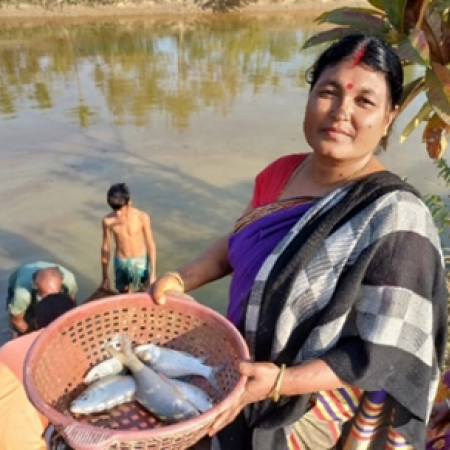
Sonmoni Devi, a farmer from Dorongi Village on the Brahmaputra's south bank, has seen a remarkable rise in her fish farming profits, doubling her income between 2023 and 2024. In rural Assam, women like Sonmoni are diversifying farming practices to support their families and promote sustainable livelihoods for future generations. Before 2022, Sonmoni relied solely on agriculture, but after receiving training under the Indo-German development cooperation project Sustainable Aquaculture for Food and Livelihood (SAFAL), she embraced aquaculture. The project, implemented by GIZ and funded by the German Federal Ministry for Economic Cooperation and Development (BMZ) in partnership with the Ministry of Fisheries, Animal Husbandry and Dairying (MoFAHD), Government of India aims to increase sustainable fish production and incomes in Assam.
Sonmoni, along with over 6,000+ farmers, has been trained in resource-conserving aquaculture techniques and financial literacy. Her journey into fish farming started with CRP (Community Resource Person) training, which she received through the Borbeel Farmer Producer Company in Nagaon. The CRP model, part of the SAFAL project, trains local farmers to support up to 25 others. Sonmoni completed a 14-session training that covered essential methods of sustainable fish farming.
Through the training, Sonmoni learned scientific methods such as adequate stocking to avoid overcrowding, improving plankton growth for natural fish food, and creating nutritious fish feed. These techniques led her to expand her fishpond from 0.06 to 0.20 hectares, leasing additional ponds for commercial fish farming. In the 2023-2024 season, she increased her fish production from 150 to 200 kilograms, doubling her income in the process.
Sonmoni has become a leader in her community, not only through her own success but by empowering other women. As President of Dorongi Gaon Parijaat Gramyo Sangathan, a village organization of 215 women, she supports 17 aquaculture farmers, 15 of whom are women. Her efforts have inspired others to adopt sustainable aquaculture practices, aligning with agroecological principles and advancing women's empowerment.
"Receiving the CRP training was life-changing. It allowed me to share knowledge and uplift my community while promoting women’s empowerment," says Sonmoni. Her story reflects the transformative power of sustainable aquaculture and highlights the critical role women play in driving change in rural Assam.
